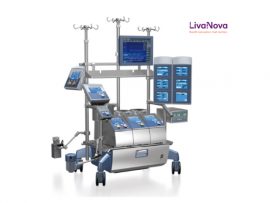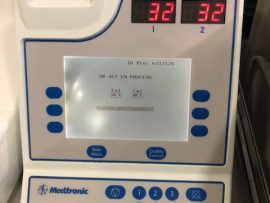Abstract Background: Metastatic spine tumor surgery (MSTS) is often complex and extensive leading to significant blood loss. Allogeneic blood transfusion (ABT) is the mainstay of blood replenishment but with immune-mediated..
Read MoreAbstract Background Excessive perioperative bleeding is associated with major complications in cardiac surgery, resulting in increased morbidity, mortality, and cost. Methods An international expert panel was convened to develop consensus..
Read MoreAbstract Objective Wide interhospital variation exists in cardiac surgical postoperative transfusion rates. We aimed to compare transfusion rates at 2 hospitals and identify the institutional practice factors, unrelated to patient..
Read MoreAbstract Intraoperative cell salvage (IOCS) allows the collection, treatment, and retransfusion of shed blood from the surgical field and cardiopulmonary bypass (CPB) collector during cardiac surgery. This technique has been..
Read MoreAbstract Background The administration of blood components and their alternatives can be lifesaving. Anaemia, bleeding and transfusion are all associated with poor peri-operative outcomes. Considerable changes in the approaches to..
Read MoreAbstract Rationale Postpartum haemorrhage (PPH), defined as a blood loss of 500 mL or more within 24 hours of birth, is the leading global cause of maternal morbidity and mortality...
Read MoreAbstract Transfusion of blood products following cardiothoracic surgery represents a significant proportion of national blood product usage, has significant cost implications and is associated with increased 30-day mortality. Following identification..
Read MoreAbstract Bombay blood (hh blood) is a rare blood group (4 per million), with no expression of the H antigen present in blood group O. Bombay blood patients can only..
Read MoreAbstract Background: The impact of intraoperative starch-based fluid therapy on postoperative kidney dysfunction in patients undergoing major abdominal surgery is uncertain. Low molecular weight starch is expected to cause less..
Read MoreAbstract Background: Monitoring the anticoagulant effect of unfractionated heparin (UFH) in extracorporeal membrane oxygenation (ECMO) patients is complex but critically important to balance the risks of treatment related bleeding and..
Read MoreAbstract BACKGROUND: Obstetric patient blood management (PBM) strategies were used at Corniche Hospital in 2018, initially focusing on minimizing bleeding, with other clinical strategies implemented incrementally. This study assesses program..
Read MoreAbstract Background: The use of cell salvage and autologous blood transfusion is an important and widespread method of blood conservation during surgeries with expected high blood loss. The continuous autotransfusion..
Read MoreAbstract Veno-venous extracorporeal membrane oxygenation (VV-ECMO) is an established supportive therapy for severe and potentially reversible acute respiratory distress syndrome (ARDS) [, ]. Despite improving patient outcomes, including reducing mortality, VV-ECMO..
Read MoreAbstract Extracorporeal membrane oxygenation in a venovenous configuration (VV-ECMO) is increasingly recognized as an important therapeutic option for patients with severe acute respiratory distress syndrome (ARDS). Accumulating scientific evidence as well..
Read MoreAbstract Background Acute kidney injury (AKI) poses a significant challenge in pediatric cardiac surgery, having a profound impact on patient morbidity and mortality. This study aims to determine the incidence..
Read MoreAbstract Thrombin generation (TG) is reduced after cardiac surgery using cardiopulmonary bypass (CPB), contributing to coagulopathy and bleeding. Plasma transfusion or four-factor prothrombin complex concentrate (PCC) are commonly used to..
Read MoreAbstract Introduction The impact of non heparin-induced thrombocytopenia on the clinical outcomes for pediatric cardiac surgery patients who required veno-arterial extracorporeal membrane support (VA-ECMO) for failure to wean from cardiopulmonary..
Read MoreAbstract BACKGROUND Cardiac surgery involving cardiopulmonary bypass (CPB) is associated with the risk of acquired coagulopathy, including dysregulated fibrinolysis, which can result in life-threatening bleeding complications. Aprotinin, an antifibrinolytic agent,..
Read MoreAbstract Introduction Extracorporeal membranous oxygenation (ECMO) as a salvage therapy for patients with severe acute respiratory distress syndrome (ARDS) has been described but experience is limited in burn cases. Few..
Read MoreAbstract Introduction The efficacy and outcomes of on-pump and off-pump coronary artery bypass grafting (CABG) remain uncertain, especially in Latin America. Our study aims to explore survival and shortand mid-term..
Read MoreAbstract Background The incidence and prognostic impact of major bleeding (MB) after percutaneous coronary intervention (PCI) and coronary artery bypass grafting (CABG) for left main coronary artery disease (LMCAD) are..
Read MoreAbstract Background and Objective Patients undergoing cardiac surgery consume more than 50% of blood transfusions, and such transfusions have been associated with increased morbidity and mortality. Evidence in blood-saving techniques..
Read MoreAbstract Background and Objectives Transfusions are common, but their use is decreasing in some countries as a result of increased risk awareness and the implementation of patient blood management (PBM),..
Read MoreAbstract During retrograde autologous priming (RAP), some patients develop hypotension and hemodynamic instability, which impedes the procedure. This study aimed to demonstrate the effects of RAP on transfusion requirements and..
Read MoreAbstract Objectives: To test feasibility of a randomized controlled trial (RCT) with an endpoint of time at goal anticoagulation in children on extracorporeal membrane oxygenation (ECMO) randomized to receive bivalirudin..
Read MoreAbstract Anticoagulation is an essential component of optimal extracorporeal membrane oxygenation (ECMO) management. Unfractionated heparin is still the anticoagulant of choice in most centers due to longstanding familiarity with the..
Read MoreAbstract Transfusion of packed red blood cell (RBCs) saves millions of lives yearly worldwide, making packed RBCs the most commonly administered drug in hospitals after vaccines. However, not all blood..
Read MoreAbstract Background Veno-venous extracorporeal membrane oxygenation (VV-ECMO) is a supportive therapy for acute respiratory failure with increased risk of packed red blood cells (PRBC) transfusion. Blood cell salvage (BCS) aims..
Read MoreAbstract Background Clinical blood resources are scarce and autologous blood transfusion for extracorporeal membrane oxygenation (ECMO) withdrawal is less studied. Objectives To assess the use of staged autotransfusion during ECMO..
Read MoreAbstract Objective: To assess the impact of post-protamine neutralisation activated clotting time (ACT) values on postoperative outcomes including chest drain output, transfusion requirements, and CICU stay, in patients undergoing cardiac surgery...
Read More














